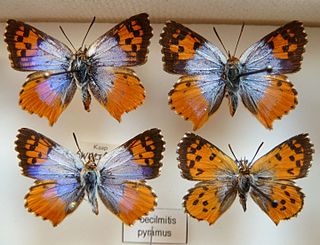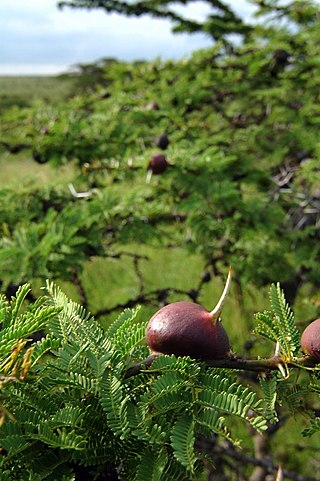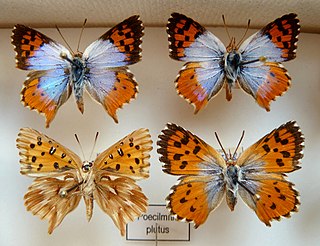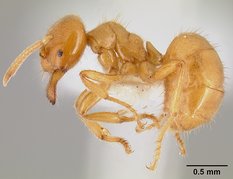Dickson's copper or Dickson's strandveld copper is a species of butterfly in the family Lycaenidae. It is endemic to South Africa, where it is only known inland from Witsand in a single spot in fynbos. Previously, it was also found north of Cape Town. It is sometimes separated in the monotypic genus Oxychaeta.

Chrysoritis pyramus, the Pyramus opal, is a species of butterfly in the family Lycaenidae. It is endemic to South Africa, where it is found on the northern slopes of the Swartberg, the Kammanassie Mountains and the Langeberg in the Western Cape.

Chrysoritis rileyi, the Riley's opal, is a species of butterfly in the family Lycaenidae. It is endemic to South Africa, where it is known only from hill slopes and river flats at the east end of the Brandvlei Dam in the Western Cape.

Crematogaster is an ecologically diverse genus of ants found worldwide, which are characterised by a distinctive heart-shaped gaster (abdomen), which gives them one of their common names, the Saint Valentine ant. Members of this genus are also known as cocktail ants because of their habit of raising their abdomens when alarmed. Most species are arboreal (tree-dwelling). These ants are sometimes known as acrobat ants.

Trophobiosis is a symbiotic association between organisms where food is obtained or provided. The provider of food in the association is referred to as a trophobiont. The name is derived from the Ancient Greek τροφή (trophē), meaning "nourishment", and -βίωσις (-biosis), which is short for the English word symbiosis.

Vachellia drepanolobium, more commonly known as Acacia drepanolobium or whistling thorn, is a swollen-thorn acacia native to East Africa. The whistling thorn grows up to 6 meters tall. It produces a pair of straight spines at each node, some of which have large bulbous bases. These swollen spines are naturally hollow and occupied by any one of several symbiotic ant species. The common name of the plant is derived from the observation that when wind blows over bulbous spines in which ants have made entry and exit holes, they produce a whistling noise.

Acromyrmex is a genus of New World ants of the subfamily Myrmicinae. This genus is found in South America and parts of Central America and the Caribbean Islands, and contains 33 known species. Commonly known as "leafcutter ants" they comprise one of the two genera of advanced attines within the tribe Attini, along with Atta.
Chrysoritis zonarius, the donkey daisy copper or Coetzer's daisy copper, is a butterfly of the family Lycaenidae. It is found in South Africa, along the coast and inland from the Cape Peninsula, north-west to Paleisheuwel and Lambert's Bay and along the hills to the Western Cape.

Chrysoritis felthami, the Feltham's opal, is a butterfly of the family Lycaenidae. It is found in South Africa. It was originally described by Roland Trimen under the name Zeritis felthami. This species was named in honour of Henry Louis Langley Feltham.

Chrysoritis palmus, the water opal, is a butterfly of the family Lycaenidae. It is found in South Africa.

Chrysoritis thysbe, the opal copper or common opal, is a butterfly of the family Lycaenidae. It is found in South Africa.
Chrysoritis violescens, the violet opal, is a butterfly of the family Lycaenidae found only in South Africa.

Chrysoritis beaufortius, the Beaufort opal, is a butterfly of the family Lycaenidae found only in South Africa.
Chrysoritis brooksi, the Brook's opal, is a butterfly of the family Lycaenidae found only in South Africa.

Chrysoritis plutus, the Plutus opal, is a butterfly of the family Lycaenidae found only in South Africa.

Acropyga acutiventris is an ant in the subfamily Formicinae. It lives underground in tropical regions and forms a mutualistic association with the mealybug, Xenococcus annandalei.

Crematogaster scutellaris is a species of ant belonging to the family Formicidae, subfamily Myrmicinae.

Crematogaster carinata is a species of ant in the tribe Crematogastrini. It was first described by Gustav Mayr in 1862. It is native to Central and South America, where it is a common species, forming large colonies in the canopy of the forest.

Many species of Staphylinidae have developed complex interspecies relationships with ants, known as myrmecophily. Rove beetles are among the most rich and diverse families of myrmecophilous beetles, with a wide variety of relationships with ants. Ant associations range from near free-living species which prey only on ants, to obligate inquilines of ants, which exhibit extreme morphological and chemical adaptations to the harsh environments of ant nests. Some species are fully integrated into the host colony, and are cleaned and fed by ants. Many of these, including species in tribe Clavigerini, are myrmecophagous, placating their hosts with glandular secretions while eating the brood.

Manica rubida is a species of ant in the subfamily Myrmicinae.


















